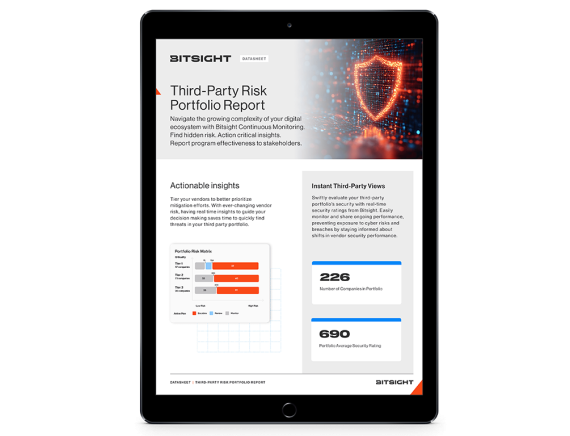Download our vendor portfolio risk report sample to get an exclusive look at the actionable reporting capabilities third party risk management teams can use to reduce critical portfolio risk.
5 Tips to Improve Cyber Security Monitoring of Your Vendors

What’s the biggest struggle your vendor risk managers face when establishing cyber security monitoring processes? From sudden increases in the use of third-parties by your organization, to not knowing which vendors might be impacted by the current data breach, vendor risk managers are plagued by challenges and roadblocks that impede their program efficiency.
With the right tools and updated processes, vendor risk managers can master cyber security monitoring to reduce the risk their vendor pool adds to their business.
Why Should You Worry Now?
There’s always been inherent risk when working with a new vendor. Each additional network onboarded into your landscape adds new points of attack for bad actors looking to access company data. Your team is also likely relying on your third-parties to accurately report out on their cybersecurity controls, when in reality they might not know about the risks living in their network. Just look at the Microsoft Hafnium attack, where even after organizations patched their systems and updated their Microsoft Exchange programs, their systems were still found to be vulnerable within the Bitsight network because hackers had installed backdoors, and were living undetected within networks globally.
So how can vendor risk managers establish cyber security monitoring processes that better protect their network if they can’t see the vulnerabilities? Below are five tips to improve cyber security monitoring and gain more visibility into the threats living in your vendor network.
1) Validate Your Vendor’s Data
Even in the best vendor relationship, it is hard to trust that the information a vendor is telling you about their cybersecurity program is accurate. When conducting proper cyber security monitoring, you want to believe that they do proper routine scanning, that their employees use only work-secure devices on the company network, or that there hasn’t been malware of malicious activity detected on the vendors network at all. But if a vendor is falsely portraying their cybersecurity controls; it might take a data breach before you find out.
Your vendor might not even know that their information isn’t accurate. If third party data only represents performance over a specific timeframe, there could be events or vulnerabilities present outside of that data you’re collecting during cyber security monitoring that the vendor isn’t aware of.
Instead of relying solely on vendor assessments as the source of information you receive during cyber security monitoring, you can validate vendor data with an external viewpoint. Using a cybersecurity rating, like Bitsight, you can see an objective, data-backed view of a vendor’s network. Bitsight Security Ratings point to specific areas of risk in a vendor’s network so there isn’t any confusion, or wasted resources, when looking to patch the vulnerability.
2) Don’t Treat Every Vendor the Same
Not every vendor poses the same risk to your network. If you’re onboarding a vendor that’s providing swag for a team bonding event, does it make sense to use the same cyber security monitoring process as you do for the vendor providing employee benefits?
Certain vendors work more closely with your organization’s sensitive data, so they should definitely be evaluated more closely during your cyber security monitoring process. If you set up a tiering process when handling vendor cyber security monitoring, you can group your third parties based on how close they will work with company data and business operations.
It then becomes easier to set accepted risk thresholds and standards for evaluating the top tier third parties in your network, instead of wasting resources on lower tier vendors that don’t work with any sensitive company information. Bitsight’s Third Party Risk Management offering provides a tier recommendation feature to help organizations set up risk-based tiers, and to place new future vendors in the right tier.
3) Continuously Utilize Cyber Security Monitoring Across Your Entire Vendor Pool
You can increase your visibility into what threats are hiding in your third party network by utilizing a continuous cyber security monitoring software. With no additional resources, continuous cyber security monitoring of your third parties will give you that consistent view you need to avoid being blindsided by a cyber attack through a vendor you thought was secure. Instead of a point-in-time view from a yearly cyber security assessment or onboarding cyber risk assessment questionnaire, continuous cyber security monitoring will show you a comprehensive, up-to-date view of what risks are present in your vendor network.
Continuous cyber security monitoring with Bitsight also allows you to set risk thresholds for each tier (see above section) so that if a vendor drops below the accepted score for their tier, your vendor program management team will be notified.

4) Don’t Forget About Historical Performance
An important, and often overlooked area of cyber security monitoring is what a vendor’s historical performance looks like. A vendor might have had no cybersecurity incidents over the past year, but what if they had suffered multiple kinds of major breaches each of the five years prior?
Bitsight Cybersecurity Ratings take into account a vendor’s historical cybersecurity performance, not just what’s currently represented in their network. Including historical performance in your cyber security monitoring process for third parties gives a more complete view of what the vendor’s current performance accurately reflects their overall program performance.
5) Present Your Findings Effectively
The final tip to improving your vendor cyber security monitoring process is to utilize proper program reports to best represent your findings. When program data is successfully presented to the board, company stakeholders, or to members of your vulnerability remediation team (maybe IT or infrastructure management teams) you want the data to be understood and actionable.
Try summarizing your cyber security monitoring updates with security ratings. As an external indicator of vendor cybersecurity performance, security ratings can be an effective metric to bring to the board to demonstrate how different vendors are performing, what risks the company is currently facing, and how your organization compares to the overall industry.
Improve Your Cyber Security Monitoring Process Today
If you’re interested in knowing more about any of these tips, or getting started using security ratings and automated solutions in your third party risk management program, contact Bitsight today!


